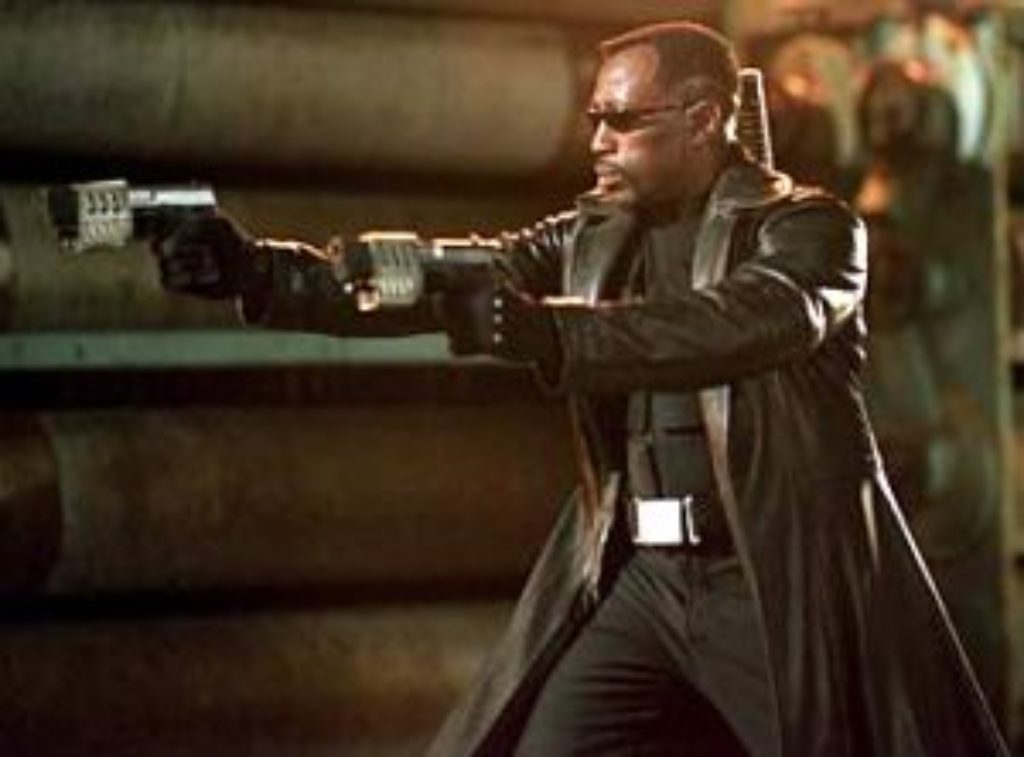
Blade, the half-vampire/half-human with all the strengths of neckbiters and none of their weaknesses, returns for one (supposedly) final episode of vampire elimination. This time, the sunglass-masked antihero faces the ultimate vampire resurrected from a century of slumber. But this Dracula (now called Drake) is no cape-clad Bela Lugosi. He’s described as the first and most perfect vampire monster, a powerful Daywalker like Blade who is nearly impossible to kill.
The vampires who woke Drake want to use his “purer” vampire blood to overcome their own weaknesses. To keep Blade out of the way, they expose him to the media and the FBI as a vigilante killer. Blade will need help, and he finds it in a group of young (human) vampire-killers who call themselves the Nightstalkers. After rescuing Blade from a vampire trap, the group—which includes the daughter of Blade’s longtime mentor and a wisecracking former vampire—hatches a risky biological plan to take out not only Drake but all vampires everywhere.
Several characters risk their own lives to save others.
Unlike other vampire stories, the Blade series removes the supernatural and spiritual from the world of bloodsuckers. Instead of being demons that inhabit the bodies of undead humans, vampirism in the Blade movies is described as a virus. Those infected (by being bitten) mutate from human to monstrous. The virus makes them deathly allergic to sunlight, garlic and silver—but they don’t respond to crosses, holy water, or other religious symbols. And they don’t talk about the devil or the power of darkness.
When a little girl asks Blade why he doesn’t just try being nice, he explains that there’s something bad inside of him and that the world isn’t a nice place. That same little girl later tells Dracula that she isn’t afraid to die because she would go to heaven. Dracula replies that after death, there is no heaven, no God, no angels, only nothingness forever.
Most of the sexual content shows up in the dialogue. “Good guy” Hannibal King, especially, uses aggressively crude sexual references both for humor and as insults for the vampires. He jokingly describes one female vampire as having fangs in her vagina and later peppers that same vampire repeatedly with very crude and degrading sexual references.
A man asks Blade if taking the serum he needs to control his vampire tendencies causes sexual arousal, and there does seem to be an element of sexuality in the way the vampires attack their victims. Nightstalker Abigail is seen in the shower cleaning blood off her body after a fight with vampires (the camera strategically avoids showing her more intimate anatomy).
While in a goth store that specializes in vampire items, Drake is shown a sexual device painted to look like the more goofy “Dracula” of lore.
The violence continues in the vein of the first two Blade films. Lots of things explode. Dozens of vampires are killed, causing them to burst into flames and disintegrate into small piles of ash. These killings result from martial arts combat, as well as being attacked with imaginative weaponry that includes specialized guns, a bow that shoots silver-tipped arrows, swords, knives and a lightsaber-style “arc.”
More disturbing are the human deaths, which include brutal “feedings,” shootings and unseen attacks resulting in significant amounts of blood—on bodies, floors and the faces of vampires. A blind woman and her child are stalked through a dark warehouse; we later see that the woman has been tortured and killed. In another warehouse, thousands of brain-dead humans are seen shrink-wrapped and hanging floor to ceiling, kept alive as a “blood farm” for the vampires.
Police officers and other humans are also shot and killed by the “good guys.” Some of the cops are corrupt; others are merely trying to stop those they believe to be killers. The final battles include prolonged scenes of brutal hand-to-hand combat.
Blade: Trinity contains pervasive profanity, including more than 30 f-words and 10 s-words. God’s name is coupled with “d–n” at least five times. Jesus’ name is abused once. Other language includes crude sexual references and sexually descriptive insults, and can be heard in songs on the film’s soundtrack.
The undead enjoy smoking. Also, Blade is drugged by his vampire captors to keep him sedated. He must regularly take a serum that works to keep his vampire tendencies from getting out of control.
Given what the “good guys” do to innocent cops on their trail, this video game of a movie can’t even be called a classic good vs. evil tale.
The third installment in the Blade series promises the ultimate showdown in the conflict between vampires and humans. But writer/director David Goyer lightens the tone a bit by reaching more for humor and straight-ahead action sequences than for apocalypse and darkness.
Bulked-up funnyman Ryan Reynolds provides much of the comic relief—as well as frequent f-words and sexual references. Jessica Biel, formerly of TV’s 7th Heaven, continues to distance herself from her “good-girl” image in her Buffy-inspired role of high-kicking vampire slayer. Wesley Snipes does little more than fight, pose, look threateningly cool and spout a few comic book phrases in his deep monotone. Lesser vampires Parker Posey and Triple H actually come off as more goofy than menacing.
The action is as bloody as ever, but this outing delivers more car chases, explosions and fight scenes than previous ones.Meaning that the film accomplishes exactly what it sets out to do—use graphic violence, graphic language, crude humor and an unchallenging plot to capture its target audience for a forgettable 105 minutes.
